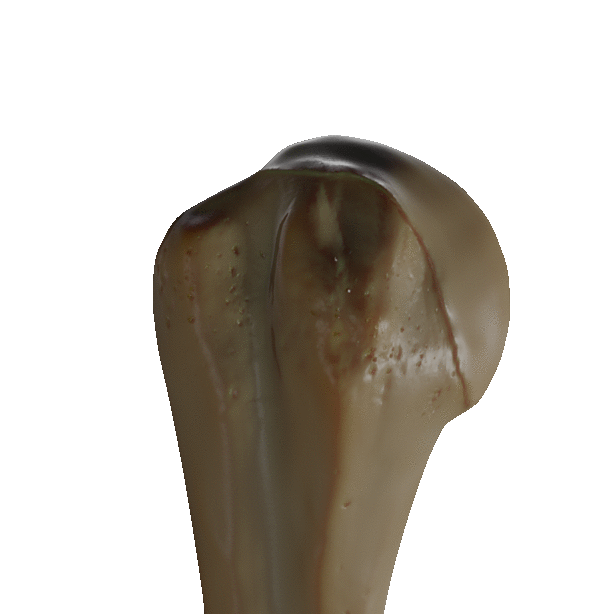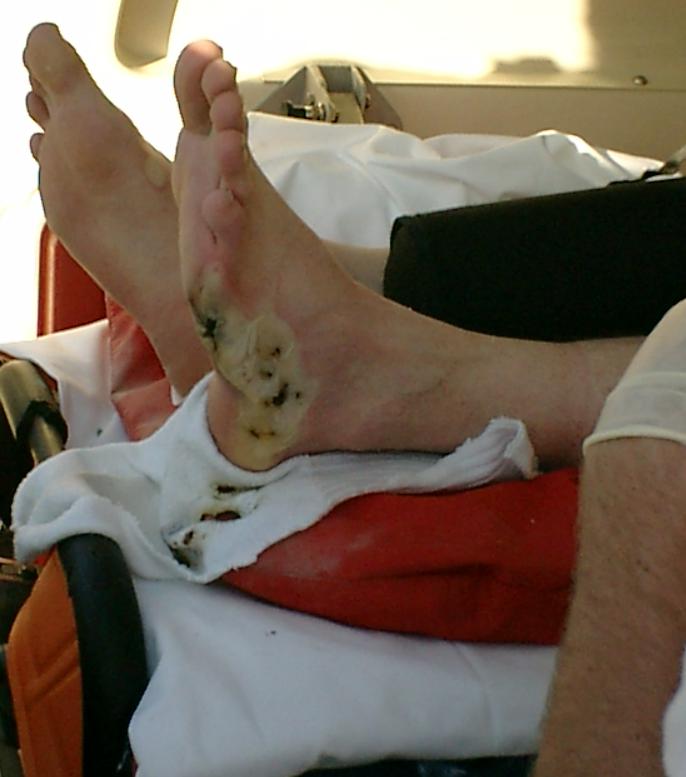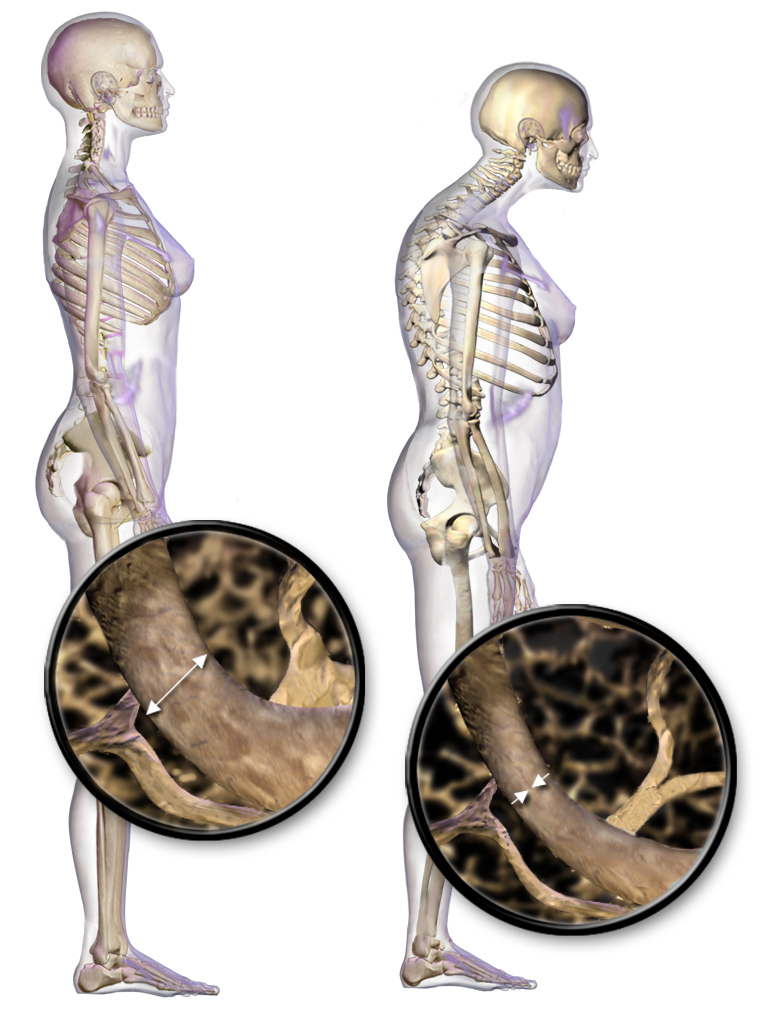|
Humerus Fracture
A humerus fracture is a break of the humerus bone in the upper arm. Symptoms may include pain, swelling, and bruising. There may be a decreased ability to move the arm and the person may present holding their elbow. Complications may include injury to an artery or nerve, and compartment syndrome. The cause of a humerus fracture is usually physical trauma such as a fall. Other causes include conditions such as cancer in the bone. Types include proximal humeral fractures, humeral shaft fractures, and distal humeral fractures. Diagnosis is generally confirmed by X-rays. A CT scan may be done in proximal fractures to gather further details. Treatment options may include a sling, splint, brace, or surgery. In proximal fractures that remain well aligned, a sling is often sufficient. Many humerus shaft fractures may be treated with a brace rather than surgery. Surgical options may include open reduction and internal fixation, closed reduction and percutaneous pinning, and intr ... [...More Info...] [...Related Items...] OR: [Wikipedia] [Google] [Baidu] |
Humerus
The humerus (; : humeri) is a long bone in the arm that runs from the shoulder to the elbow. It connects the scapula and the two bones of the lower arm, the radius (bone), radius and ulna, and consists of three sections. The humeral upper extremity of humerus, upper extremity consists of a rounded head, a narrow neck, and two short processes (tubercles, sometimes called tuberosities). The body of humerus, body is cylindrical in its upper portion, and more prism (geometry), prismatic below. The lower extremity of humerus, lower extremity consists of 2 epicondyles, 2 processes (trochlea of the humerus, trochlea and capitulum of the humerus, capitulum), and 3 fossae (radial fossa, coronoid fossa, and olecranon fossa). As well as its true anatomical neck, the constriction below the greater and lesser tubercles of the humerus is referred to as its Surgical neck of the humerus, surgical neck due to its tendency to fracture, thus often becoming the focus of surgeons. Etymology The word ... [...More Info...] [...Related Items...] OR: [Wikipedia] [Google] [Baidu] |
Open Reduction And Internal Fixation
Internal fixation is an operation in orthopedics that involves the surgical implementation of implants for the purpose of repairing a bone, a concept that dates to the mid-nineteenth century and was made applicable for routine treatment in the mid-twentieth century. An internal fixator may be made of stainless steel, titanium alloy, or cobalt-chrome alloy. Types of internal fixators include: * Plate and screws * Kirschner wires * Intramedullary nails Open reduction Open reduction internal fixation (ORIF) involves the implementation of implants to guide the healing process of a bone, as well as the open reduction, or setting, of the bone. ''Open reduction'' refers to open surgery to set bones, as is necessary for some fractures. ''Internal fixation'' refers to fixation of screws and/or plates, intramedullary rods and other devices to enable or facilitate healing. Rigid fixation prevents micro-motion across lines of fracture to enable healing and prevent infection, which h ... [...More Info...] [...Related Items...] OR: [Wikipedia] [Google] [Baidu] |
Tobacco Smoking
Tobacco smoking is the practice of burning tobacco and ingesting the resulting smoke. The smoke may be inhaled, as is done with cigarettes, or released from the mouth, as is generally done with pipes and cigars. The practice is believed to have begun as early as 5000–3000 BC in Mesoamerica and South America. Tobacco was introduced to Eurasia in the late 17th century by European colonists, where it followed common trade routes. The practice encountered criticism from its first import into the Western world onward but embedded itself in certain strata of several societies before becoming widespread upon the introduction of automated cigarette-rolling apparatus. Smoking is the most common method of consuming tobacco, and tobacco is the most common substance smoked. The agricultural product is often mixed with additives and then combusted. The resulting smoke, which contains various active substances, the most significant of which is the addictive psychostimulant drug nicotine ... [...More Info...] [...Related Items...] OR: [Wikipedia] [Google] [Baidu] |
Bone Density
Bone density, or bone mineral density, is the amount of bone mineral in bone tissue. The concept is of mass of mineral per volume of bone (relating to density in the physics sense), although medicine#Clinical practice, clinically it is measured by proxy according to optical density per square centimetre of bone surface upon medical imaging, imaging. Bone density measurement is used in clinical medicine as an indirect indicator of osteoporosis and fracture risk. It is measured by a procedure called densitometry, often performed in the radiology or nuclear medicine departments of hospitals or clinics. The measurement is painless and non-invasive and involves low radiation exposure. Measurements are most commonly made over the lumbar spine and over the upper part of the hip. The forearm may be scanned if the hip and lumbar spine are not accessible. There is a statistics, statistical association between poor bone density and higher probability of fracture. Fractures of the legs and pel ... [...More Info...] [...Related Items...] OR: [Wikipedia] [Google] [Baidu] |
Epileptic Seizure
A seizure is a sudden, brief disruption of brain activity caused by abnormal, excessive, or synchronous neuronal firing. Depending on the regions of the brain involved, seizures can lead to changes in movement, sensation, behavior, awareness, or consciousness. Symptoms vary widely. Some seizures involve subtle changes, such as brief lapses in attention or awareness (as seen in absence seizures), while others cause generalized convulsions with loss of consciousness ( tonic–clonic seizures). Most seizures last less than two minutes and are followed by a postictal period of confusion, fatigue, or other symptoms. A seizure lasting longer than five minutes is a medical emergency known as status epilepticus. Seizures are classified as provoked, when triggered by a known cause such as fever, head trauma, or metabolic imbalance, or unprovoked, when no immediate trigger is identified. Recurrent unprovoked seizures define the neurological condition epilepsy. Clinical features Seizure ... [...More Info...] [...Related Items...] OR: [Wikipedia] [Google] [Baidu] |
Electric Shock
An electrical injury (electric injury) or electrical shock (electric shock) is damage sustained to the skin or internal organs on direct contact with an electric current. The injury depends on the Current density, density of the current, tissue resistance and duration of contact. Very small currents may be imperceptible or only produce a light tingling sensation. However, a shock caused by low and otherwise harmless current could startle an individual and cause injury due to jerking away or falling. A strong electric shock can often cause painful Spasm, muscle spasms severe enough to Joint dislocation, dislocate joints or even to Bone fracture, break bones. The loss of muscle control is the reason that a person may be unable to release themselves from the electrical source; if this happens at a height as on a Overhead power line, power line they can be thrown off. Larger currents can result in tissue damage and may trigger ventricular fibrillation or cardiac arrest. If death res ... [...More Info...] [...Related Items...] OR: [Wikipedia] [Google] [Baidu] |
Ballistic Trauma
A gunshot wound (GSW) is a penetrating trauma, penetrating injury caused by a projectile (e.g. a bullet) Shooting, shot from a gun (typically a firearm). Damage may include bleeding, bone fractures, organ (anatomy), organ damage, wound infection, and Plegia, loss of the ability to move part of the body. Damage depends on the part of the body hit, the path the bullet follows through (or into) the body, and the type and speed of the bullet. In severe cases, although not uncommon, the injury is Death, fatal. Long-term complications can include bowel obstruction, failure to thrive, neurogenic bladder and paralysis, recurrent cardiorespiratory distress and pneumothorax, hypoxic brain injury leading to early dementia, amputations, chronic pain and pain with light touch (hyperalgesia), deep venous thrombosis with pulmonary embolus, limb swelling and Debility (medical), debility, and lead poisoning. Factors that determine rates of gun violence vary by country. These factors may include ... [...More Info...] [...Related Items...] OR: [Wikipedia] [Google] [Baidu] |
Traffic Collision
A traffic collision, also known as a motor vehicle collision, or car crash, occurs when a vehicle collides with another vehicle, pedestrian, animal, road debris, or other moving or stationary obstruction, such as a tree, pole or building. Traffic collisions often result in injury, disability, death, and property damage as well as financial costs to both society and the individuals involved. Road transport is statistically the most dangerous situation people deal with on a daily basis, but casualty figures from such incidents attract less media attention than other, less frequent types of tragedy. The commonly used term car accident is increasingly falling out of favor with many government departments and organizations: the Associated Press style guide recommends caution before using the term and the National Union of Journalists advises against it in their Road Collision Reporting Guidelines. Some collisions are intentional vehicle-ramming attacks, staged crashes, vehicu ... [...More Info...] [...Related Items...] OR: [Wikipedia] [Google] [Baidu] |
B Vitamins
B vitamins are a class of water-soluble vitamins that play important roles in Cell (biology), cell metabolism and synthesis of red blood cells. They are a chemically diverse class of compounds. Dietary supplements containing all eight are referred to as a vitamin B complex. Individual B vitamins are referred to by B-number or by chemical name, such as B1 for thiamine, B2 for riboflavin, and B3 for niacin, while some are more commonly recognized by name than by number, such as pantothenic acid (B5), biotin (B7), and folate (B9). B vitamins are present in protein (nutrient), protein-rich foods, such as Fish as food, fish, poultry, meat, dairy products, and Eggs as food, eggs; they are also found in Leaf vegetable, leafy green vegetables, beans, and peas. food fortification, Fortified foods, such as breakfast cereals, baked products, and infant formulas, may contain B vitamins. Each B vitamin is either a cofactor (biochemistry), cofactor (generally a cofactor (biochemistry), coenzym ... [...More Info...] [...Related Items...] OR: [Wikipedia] [Google] [Baidu] |
Osteoporosis
Osteoporosis is a systemic skeletal disorder characterized by low bone mass, micro-architectural deterioration of bone tissue leading to more porous bone, and consequent increase in Bone fracture, fracture risk. It is the most common reason for a broken bone among the Old age, elderly. Bones that commonly break include the vertebrae in the Vertebral column, spine, the bones of the forearm, the wrist, and the hip. Until a broken bone occurs there are typically no symptoms. Bones may weaken to such a degree that a break may occur with minor stress or spontaneously. After the broken bone heals, some people may have chronic pain and a decreased ability to carry out normal activities. Osteoporosis may be due to lower-than-normal peak bone mass, maximum bone mass and greater-than-normal bone loss. Bone loss increases after menopause in women due to lower levels of estrogen, and after andropause in older men due to lower levels of testosterone. Osteoporosis may also occur due to a ... [...More Info...] [...Related Items...] OR: [Wikipedia] [Google] [Baidu] |
Pulse
In medicine, the pulse refers to the rhythmic pulsations (expansion and contraction) of an artery in response to the cardiac cycle (heartbeat). The pulse may be felt ( palpated) in any place that allows an artery to be compressed near the surface of the body close to the skin, such as at the neck ( carotid artery), wrist (radial artery or ulnar artery), at the groin (femoral artery), behind the knee ( popliteal artery), near the ankle joint ( posterior tibial artery), and on foot (dorsalis pedis artery). The pulse is most commonly measured at the wrist or neck for adults and at the brachial artery (inner upper arm between the shoulder and elbow) for infants and very young children. A sphygmograph is an instrument for measuring the pulse. Physiology Claudius Galen was perhaps the first physiologist to describe the pulse. The pulse is an expedient tactile method of determination of systolic blood pressure to a trained observer. Diastolic blood pressure is non-palpable and ... [...More Info...] [...Related Items...] OR: [Wikipedia] [Google] [Baidu] |
820 Humerus Radius Fractures (cropped)
8 (eight) is the natural number following 7 and preceding 9. Etymology English ''eight'', from Old English '', æhta'', Proto-Germanic ''*ahto'' is a direct continuation of Proto-Indo-European '' *oḱtṓ(w)-'', and as such cognate with Greek and Latin , both of which stems are reflected by the English prefix oct(o)-, as in the ordinal adjective ''octaval'' or ''octavary'', the distributive adjective is ''octonary''. The adjective ''octuple'' (Latin ) may also be used as a noun, meaning "a set of eight items"; the diminutive ''octuplet'' is mostly used to refer to eight siblings delivered in one birth. The Semitic numeral is based on a root ''*θmn-'', whence Akkadian ''smn-'', Arabic ''ṯmn-'', Hebrew ''šmn-'' etc. The Chinese numeral, written (Mandarin: ''bā''; Cantonese: ''baat''), is from Old Chinese ''*priāt-'', ultimately from Sino-Tibetan ''b-r-gyat'' or ''b-g-ryat'' which also yielded Tibetan '' brgyat''. It has been argued that, as the cardinal num ... [...More Info...] [...Related Items...] OR: [Wikipedia] [Google] [Baidu] |







